Can Amazon trees keep up?
New research from the University of Leeds and a collaboration of 30 global institutions suggests that Amazon tree diversity is under extreme threat by climate change. Looking at data from a hundred plots from the Amazon Forest Inventory Network over 30 years, the scientists determined the warming planet has drastically changed species composition within the Amazon.
Tracking individual trees growth and mortality over the past 30 years,the scientists found that moisture-loving trees are dying more often than other species. Nevertheless, species suited to drier climates were unable to adapt to replace those moisture-loving trees that were dying off, resulting in a gap in tree diversity as well as a decline in population numbers.
“The ecosystem’s response is lagging behind the rate of climate change. The data shows us that the droughts that hit the Amazon basin in the last decade had serious consequences for forest makeup, with higher mortality in tree species most vulnerable to droughts and not enough compensatory growth in species better equipped to survive dryer conditions,” said lead author of the study Dr. Adriane Esquivel Muelbert.
This research also confirms previous studies that have reported that canopy tree species in rainforests will be better equipped in a world with climate change because they thrive with more carbon dioxide. Due to this, species composition in the Amazon rainforest will likely change in the coming decades of warmer climate. Smaller understory plants will have difficulty growing in the shade of larger canopy trees. This will in turn have a significant impact on wildlife in these regions as well.
Co-author Oliver Phillips commented that “The impact of climate change on forest communities has significant consequences for rainforest biodiversity. The species most vulnerable to drought are doubly at risk, as they are typically the ones restricted to fewer locations in the heart of the Amazon, which makes them more likely to become extinct if this process continues. Our findings highlight the need for strict measures to protect existing intact rainforest. Deforestation for agriculture and livestock is known to intensify the droughts in this region, exacerbating the effects already caused by global climate.”
According to one study, land clearing for cattle ranching accounts for an estimated 70% of deforestation in the Amazon basin. Additionally, the agricultural practice of slash and burn results in man made forest fires that emit more carbon dioxide into the atmosphere and increase erosion in already degraded areas.
The only upside from this study points to several pioneer tree species in the Amazon rainforest that have grown in the last decades. The scientists hope that these species will be able to compensate for the extreme downfall in biodiversity due to climate change.
Sources: Science Daily, Global Change Biology









